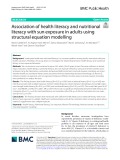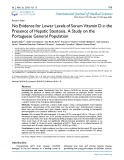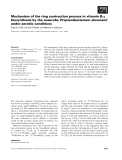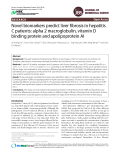
Vitamin D knowledge
-
Inadequate health and nutritional literacy is a common problem among adults, associated with poor health outcomes. Therefore, this study aimed to investigate the relationship between health literacy and nutritional literacy to sun exposure behaviour.
 9p
9p  viferrari
viferrari
 28-11-2022
28-11-2022
 16
16
 2
2
 Download
Download
-
Nursing home residents are in high risk of vitamin D defciency, which negatively affects bone health. Vitamin D and calcium supplements haves shown to increase bone density and reduce fracture risk. Therefore, The Danish Health Authority recommends all nursing home residents a daily supplement of 20μg vitamin D and 800–1000mg calcium. However, adherence to the recommendation and knowledge of it is unknown. The aims of this study were to investigate adherence, knowledge, and potential barriers to this recommendation in Denmark.
 9p
9p  vinobelprisen
vinobelprisen
 26-03-2022
26-03-2022
 13
13
 5
5
 Download
Download
-
The prevalence of vitamin D deficiency in the kingdom of Saudi Arabia is rising unexpectedly in every age group. Apart from several risk factors, the lack of awareness is posing a serious threat for low vitamin D levels in children as well.
 6p
6p  vichengshin2711
vichengshin2711
 26-02-2020
26-02-2020
 10
10
 0
0
 Download
Download
-
Nonalcoholic fatty liver disease (NAFLD) has become highly prevalent, paralleling the pandemic of obesity and diabetes, and represents an important burden. Nutrition knowledge is fundamental, in prevention, evolution and treatment of NAFLD.
 9p
9p  vihasaki2711
vihasaki2711
 12-11-2019
12-11-2019
 15
15
 1
1
 Download
Download
-
The mechanism of the ring contraction process during vitamin B12 biosyn-thesis by the anaerobe Propionibacterium shermaniiwas investigated under both aerobic and anaerobic conditions by means of feeding experiments withd-amino[1-13 C]levulinic acid (a biosynthetic intermediate of tetra-pyrrole) and d-amino[1-13 C,1,1,4-18 O3]levulinic acid in combination with 13 C-NMR spectroscopy.
 7p
7p  galaxyss3
galaxyss3
 19-03-2013
19-03-2013
 40
40
 3
3
 Download
Download
-
Limited data suggest that the risk of squamous cell carcinoma is similarly increased after first use as a teenager. Artificial tanning confers little if any protection against solar damage to the skin, nor does use of indoor tanning facilities grant protection against vitamin D deficiency. Data also suggest detrimental effects from use of indoor tanning facilities on the skin’s immune response and possibly on the eyes (ocular melanoma). Knowledge of levels of UV exposure during indoor tanning is very imprecise.
 108p
108p  khongmuonnghe
khongmuonnghe
 07-01-2013
07-01-2013
 46
46
 3
3
 Download
Download
-
Not so many years ago, the world vitamin was known only to a few scientists. Today it is very widely used, and the importance of vitamins in our foods is common knowledge. Vitamins are life-giving substances found in foods and are needed for the proper growth and general health of the body. The different kinds of vitamins are indicated by letters of the alphabet. At the present time, vitamins A, B1, B2, C, D, E and G are know. A proper diet should contain a collection
 5p
5p  toiyeuvietnam0106
toiyeuvietnam0106
 17-08-2012
17-08-2012
 1068
1068
 39
39
 Download
Download
-
The gold standard of assessing liver fibrosis is liver biopsy, which is invasive and not without risk. Therefore, searching for noninvasive serologic biomarkers for liver fibrosis is an importantly clinical issue. Methods: A total of 16 healthy volunteers and 45 patients with chronic hepatitis C virus (HCV) were enrolled (F0: n = 16, F1: n = 7, F2: n = 17, F3: n = 8 and F4: n = 13, according to the METAVIR classification). Three serum samples of each fibrotic stage were analyzed by two-dimension difference gel electrophoresis (2D-DIGE). The differential proteins were identified by...
 7p
7p  toshiba23
toshiba23
 18-11-2011
18-11-2011
 53
53
 3
3
 Download
Download
-
Flavonoids Flavonoids constitute a large family of polyphenols that contribute to the aroma, taste, and color of fruits and vegetables. Major groups of dietary flavonoids include anthocyanidins in berries; catechins in green tea and chocolate; flavonols (e.g., quercitin) in broccoli, kale, leeks, onion, and the skins of grapes and apples; and isoflavones (e.g., genistein) in legumes. Isoflavones have a low bioavailability and are partially metabolized by the intestinal flora.
 5p
5p  konheokonmummim
konheokonmummim
 03-12-2010
03-12-2010
 79
79
 5
5
 Download
Download
CHỦ ĐỀ BẠN MUỐN TÌM





















